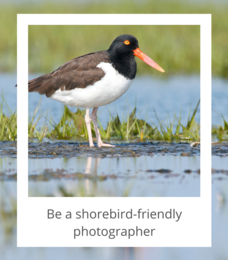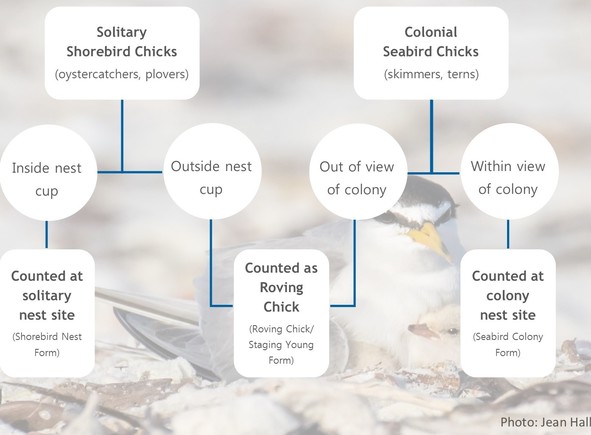Events:
June 30: Shorebirds of Southwest Florida. Register at Collier County Public Library.
Reminder:
June 10 - 16: the June count window for the Breeding Bird Protocol. Whenever possible, weekly surveys are preferred for routes with active nesting; it helps capture information about peak counts.
All Summer: Beach stewards are needed at important beach nesting sites. Check out the map of local stewardship opportunities and contact us to get involved!

Be a Shorebird-friendly Photographer
Photography of shorebirds and seabirds along Florida’s shores is a popular activity. Observing shorebirds and seabirds can be exciting, and admirers are often eager to photograph the charismatic birds that take residence on the beaches each year. When taking photos, please take great care to avoid disturbing the birds, and their nests and chicks. Many shorebird populations are in decline, due in part to human disturbance. By photographing shorebirds without disturbing them, you help protect and conserve them. If you are one of the lucky people to encounter and photograph shorebirds and seabirds, please remember how to be a shorebird-friendly photographer.
When photographing a bird on a nest:
Remain outside the posted area. No part of you or your camera equipment should go beyond the string or signs. If the area around the nest is not staked off, you should remain far enough away to avoid disturbing the birds (typically 300 feet). If the birds show any sign of agitation as a result of your presence, quietly and slowly retreat until the birds no longer appear disturbed.
Stay far enough away for the bird to remain on its nest. Back off immediately if you flush a bird. Sometimes birds nest near the edge of a posted boundary, so even if you are outside the string, if the bird responds to you, you’re too close.
Scan for shorebird and seabird predators. Make sure there are no predators nearby such as raccoons, cats, and crows that may be attracted to human presence or scent. They are alert to movement, so by flushing a bird, you may inadvertently help predators notice birds that would otherwise have remained camouflaged.
Stay 10 minutes or less. Too much time near the nest may unduly stress the birds. Be considerate and do not spend more than 10 minutes near the nest.
If other photographers are present, try to coordinate your time near the nest, and leave the area together, so that the birds have at least three hours of undisturbed time.
Don’t specify the nest’s exact location when sharing or publishing photos. Advertising the birds’ nesting location may draw additional disturbance to the nest.
When photographing birds that are away from their nests, or birds with chicks:
Stay at least 100 ft away from the birds. Wait for the birds to approach you for closer shots. Stay far enough away so the birds do not change their behavior in response to your presence.
Don’t “push” the birds around the beach. Birds need to be able to feed and rest without disturbance. Shorebird chicks must constantly forage to gain enough weight to fledge in time, so any time taken away from foraging can be harmful to their health and survival.
For more details, read "How to Be a Shorebird-friendly Photographer".
|

Sea Turtle and Shorebird Monitors: When You're on the Beach
Summer is in the air, and for shorebirds and sea turtles, eggs are on, or in, the beach. And that means Florida Shorebird Alliance (FSA) Partners and Marine Turtle Permit Holders (MTPH) are also on the beach. If you’re one of the persons working for the conservation of Florida’s sea turtles and shorebirds, there are a few things to remember during your time on the sand.
Sea turtles access the beach at night to bury their eggs within the sand, usually ten inches or deeper. The eggs of shorebirds, however, are laid on the open sand. Also, unlike sea turtle hatchlings, flightless chicks remain on the beach until they are fledged – and they don’t just remain in the posted areas. Chicks of both colonial and solitary nesters can be anywhere on the beach from the waterline up to the dunes, and they can travel far from the original marked nest site. The primary defensive response for flightless chicks is to freeze and press against the sand surface, which makes them vulnerable to foot and vehicle traffic.
During the shorebird nesting season, FSA partners post nesting areas by encircling the area with posts and flagging or twine. The time frame from nest initiation to fledging of seabird and shorebird chicks is typically no longer than 60 days and determines how long an area is posted. However, because nests are asynchronous (not all nests are initiated on the same day), if there is more than one nest within a posted area such as in a large seabird colony, this time frame may stretch out over a longer period. Because each posted area is unique, it is best for MTPH and shorebird monitors to coordinate closely to determine the anticipated completion date for nesting at any site.
When surveying on the beach please remember to respect posted areas, as often there will be eggs and chicks on the ground. Any disturbance within the site could cause the adult birds to flush, leaving eggs and chicks vulnerable to predation, exposure to the intense heat from the sun, or starvation. Chicks may become separated from their parents during a disturbance event, or adults may permanently abandon a nest due to human disturbance.
Seabirds and shorebirds are protected under state and federal laws, and there can be legal ramifications for anyone entering a posted area, even with the best intentions. MTPH that survey a beach with posted shorebird nests must be extra vigilant, both on an ATV and on foot, during early morning surveys to watch for shorebird chicks and fledglings. Sea turtle nest surveyors must respect the posted area, entering only if specifically authorized to do so by FWC staff at MTP@myfwc.com.
It is still important to get accurate information on any sea turtle crawls that might occur within posted shorebird areas or adjacent to posted nests. Marine Turtle Permit Holders should observe the crawl to the degree possible from the outside of the posted area and install a marker outside the postings or away from the solitary nest to indicate the approximate location of the crawl or nest. Once the postings for the birds are removed, the MTPH can enter the area and post as large a section as needed for protection of any potential sea turtle nests. Sea turtle nest inventories should be done after the postings are removed. If you are a Marine Turtle Permit Holder or a shorebird monitor and have questions about posted areas, please contact shorebird@myfwc.com or mtp@myfwc.com and we will help you.
Thank you for your work protecting Florida’s sea turtles and shorebirds!
|

Data Entry Tips
The 2022 breeding season is in full swing – nests are hatching, rooftops are active, and chicks are beginning to run around! Thank you to all FSA partners that have been busy collecting and entering data. In all the bustle of breeding season activity, you may find yourself mystified over how to best enter the data you collected. Never fear! You can always email the Data Team at FLShorebirdDatabase@myFWC.com and we will be happy to demystify any questions you have. You can also check out some data entry tips below!
Rooftops:
There are three options to report rooftop nesting status:
-
No Nesting Yet This Year: If no shorebirds or seabirds were seen at the rooftop yet this breeding season, then the nest status should be reported as No Nesting Yet This Year.
-
Active: As soon as any rooftop nesting shorebirds or seabirds are seen using the roof, then the nest status should be reported as Active. The rooftop will be considered Active for as long as birds are seen on roof, hovering over the roof, or flying to and from the roof.
-
No Longer Active: Rooftops are considered No Longer Active when birds that were nesting on the rooftop are not currently present at the rooftop.
Remember that a rooftop can only be reported as No Longer Active if it was previously Active at some point during the current breeding season. Likewise, once a rooftop has been reported as Active, it cannot be later be reported as No Nesting Yet This Year. Instead, it should be reported as No Longer Active. If birds later return to the rooftop for another nesting attempt, then the rooftop can be report as Active again.
Count Types:
If you have found yourself puzzling over count types, you are not alone! For instance, it can be difficult to know when to record a direct count of zero (0) versus “Did Not Count”, especially when documenting additional potential breeding adults on route surveys. Use a zero (0) when you looked for but did not observe the target species during the survey. Recording “Did Not Count” indicates that you either (a) could not verify if there were or were not any of the target species present, or (b) no consistent effort was made to count the target species during the survey. Both are valid counts options, it just depends on the circumstances of your survey. To learn more about different count types, check out the Count Type Guide available on the Resources page on the FSD website.
Chick Data:
Shorebird and seabird chicks are hatching all over the state! These chicks are on the move, and we want to know where they are going. How you report chick data in the Florida Shorebird Database (FSD) varies by species (seabird vs. shorebird) and where you observed the chicks (in a nest/colony vs. away from a nest/colony).
Seabird chicks are not very mobile and depend on their parents for food, so young downy and feathered seabird chicks will remain in or very near their colony. Flight-capable chicks will begin to venture away from their colony. If seabird chicks of any age are observed in or within sight of their colony, you can enter these chick counts on the Seabird Colony Form. If flight-capable seabird chicks are observed away from or out of sight from their colony, you can enter these seabird chick counts on the Roving Chick/Staging Young Form.
Shorebird chicks are highly mobile and typically leave the nest within hours of hatching. They may even move miles away from their natal nest! Most of the time, shorebird chicks will be observed outside of the nest cup so you will report these observations on the Roving Chick/Staging Young form. In the rare instance that you do observe downy chicks still inside the nest cup, they are considered nestlings and can be reported on the Shorebird Nest Form.
Shorebird chicks can be tricky to observe. Sometimes you may observe a shorebird breeding pair acting like they have chicks, but you are not able to see any chicks. Did you know that you can still report these observations? If you are confident that the breeding pair has a brood based on the pair’s behavior, you can enter this data on the Roving Chick/Staging Young form. Note that the behavior of shorebird adults with a brood may differ by species.
For more details about age classes, check out the shorebird and seabird aging guides on the Monitoring Guidance section of the FSA website. As always, we are happy to help answer any questions about chick observations and data entry. Email any questions to us at FLShorebirdDatabase@myFWC.com!

|